Communication in Health Practitioners
VerifiedAdded on 2021/06/17
|9
|2580
|21
AI Summary
Contribute Materials
Your contribution can guide someone’s learning journey. Share your
documents today.
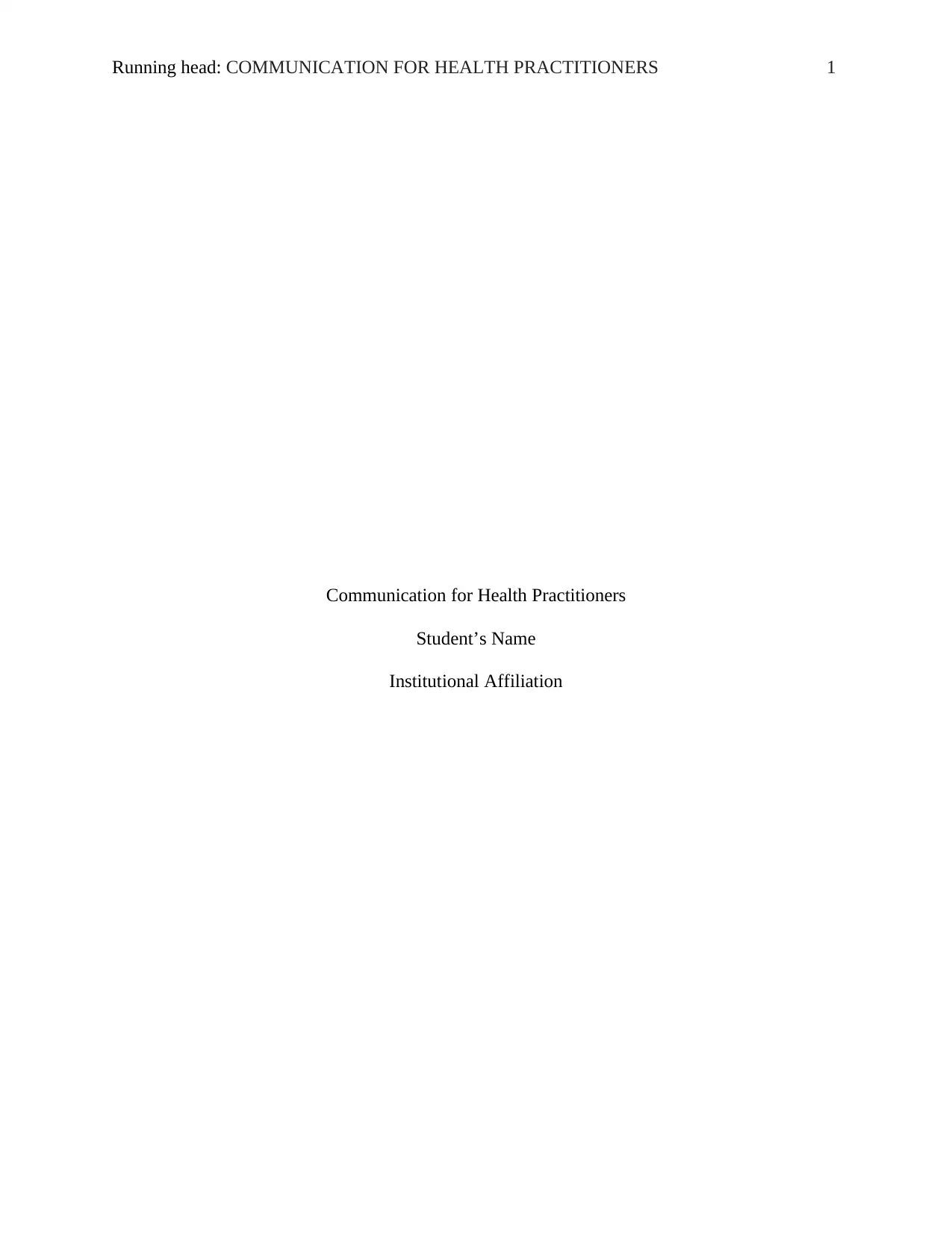
Running head: COMMUNICATION FOR HEALTH PRACTITIONERS 1
Communication for Health Practitioners
Student’s Name
Institutional Affiliation
Communication for Health Practitioners
Student’s Name
Institutional Affiliation
Secure Best Marks with AI Grader
Need help grading? Try our AI Grader for instant feedback on your assignments.
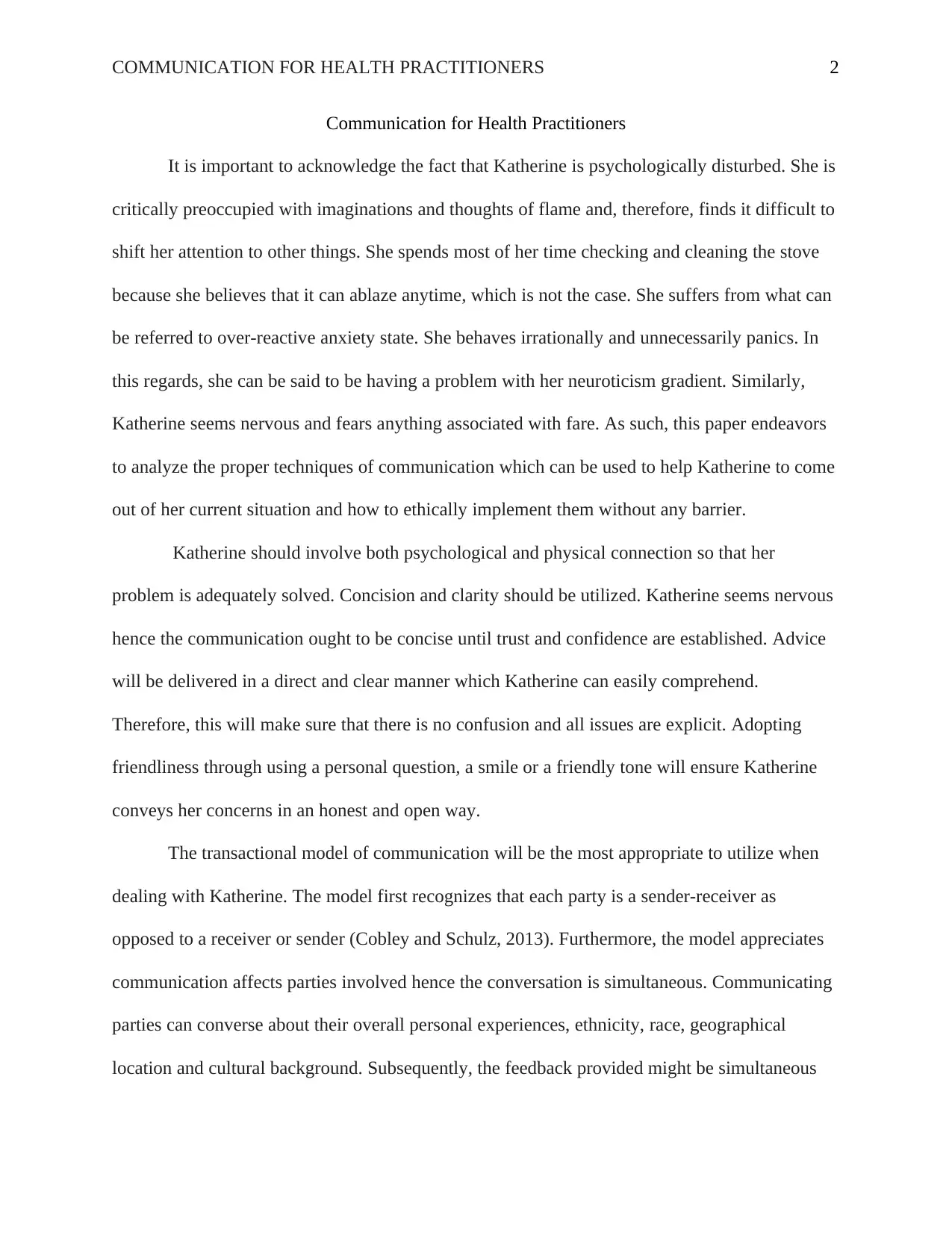
COMMUNICATION FOR HEALTH PRACTITIONERS 2
Communication for Health Practitioners
It is important to acknowledge the fact that Katherine is psychologically disturbed. She is
critically preoccupied with imaginations and thoughts of flame and, therefore, finds it difficult to
shift her attention to other things. She spends most of her time checking and cleaning the stove
because she believes that it can ablaze anytime, which is not the case. She suffers from what can
be referred to over-reactive anxiety state. She behaves irrationally and unnecessarily panics. In
this regards, she can be said to be having a problem with her neuroticism gradient. Similarly,
Katherine seems nervous and fears anything associated with fare. As such, this paper endeavors
to analyze the proper techniques of communication which can be used to help Katherine to come
out of her current situation and how to ethically implement them without any barrier.
Katherine should involve both psychological and physical connection so that her
problem is adequately solved. Concision and clarity should be utilized. Katherine seems nervous
hence the communication ought to be concise until trust and confidence are established. Advice
will be delivered in a direct and clear manner which Katherine can easily comprehend.
Therefore, this will make sure that there is no confusion and all issues are explicit. Adopting
friendliness through using a personal question, a smile or a friendly tone will ensure Katherine
conveys her concerns in an honest and open way.
The transactional model of communication will be the most appropriate to utilize when
dealing with Katherine. The model first recognizes that each party is a sender-receiver as
opposed to a receiver or sender (Cobley and Schulz, 2013). Furthermore, the model appreciates
communication affects parties involved hence the conversation is simultaneous. Communicating
parties can converse about their overall personal experiences, ethnicity, race, geographical
location and cultural background. Subsequently, the feedback provided might be simultaneous
Communication for Health Practitioners
It is important to acknowledge the fact that Katherine is psychologically disturbed. She is
critically preoccupied with imaginations and thoughts of flame and, therefore, finds it difficult to
shift her attention to other things. She spends most of her time checking and cleaning the stove
because she believes that it can ablaze anytime, which is not the case. She suffers from what can
be referred to over-reactive anxiety state. She behaves irrationally and unnecessarily panics. In
this regards, she can be said to be having a problem with her neuroticism gradient. Similarly,
Katherine seems nervous and fears anything associated with fare. As such, this paper endeavors
to analyze the proper techniques of communication which can be used to help Katherine to come
out of her current situation and how to ethically implement them without any barrier.
Katherine should involve both psychological and physical connection so that her
problem is adequately solved. Concision and clarity should be utilized. Katherine seems nervous
hence the communication ought to be concise until trust and confidence are established. Advice
will be delivered in a direct and clear manner which Katherine can easily comprehend.
Therefore, this will make sure that there is no confusion and all issues are explicit. Adopting
friendliness through using a personal question, a smile or a friendly tone will ensure Katherine
conveys her concerns in an honest and open way.
The transactional model of communication will be the most appropriate to utilize when
dealing with Katherine. The model first recognizes that each party is a sender-receiver as
opposed to a receiver or sender (Cobley and Schulz, 2013). Furthermore, the model appreciates
communication affects parties involved hence the conversation is simultaneous. Communicating
parties can converse about their overall personal experiences, ethnicity, race, geographical
location and cultural background. Subsequently, the feedback provided might be simultaneous
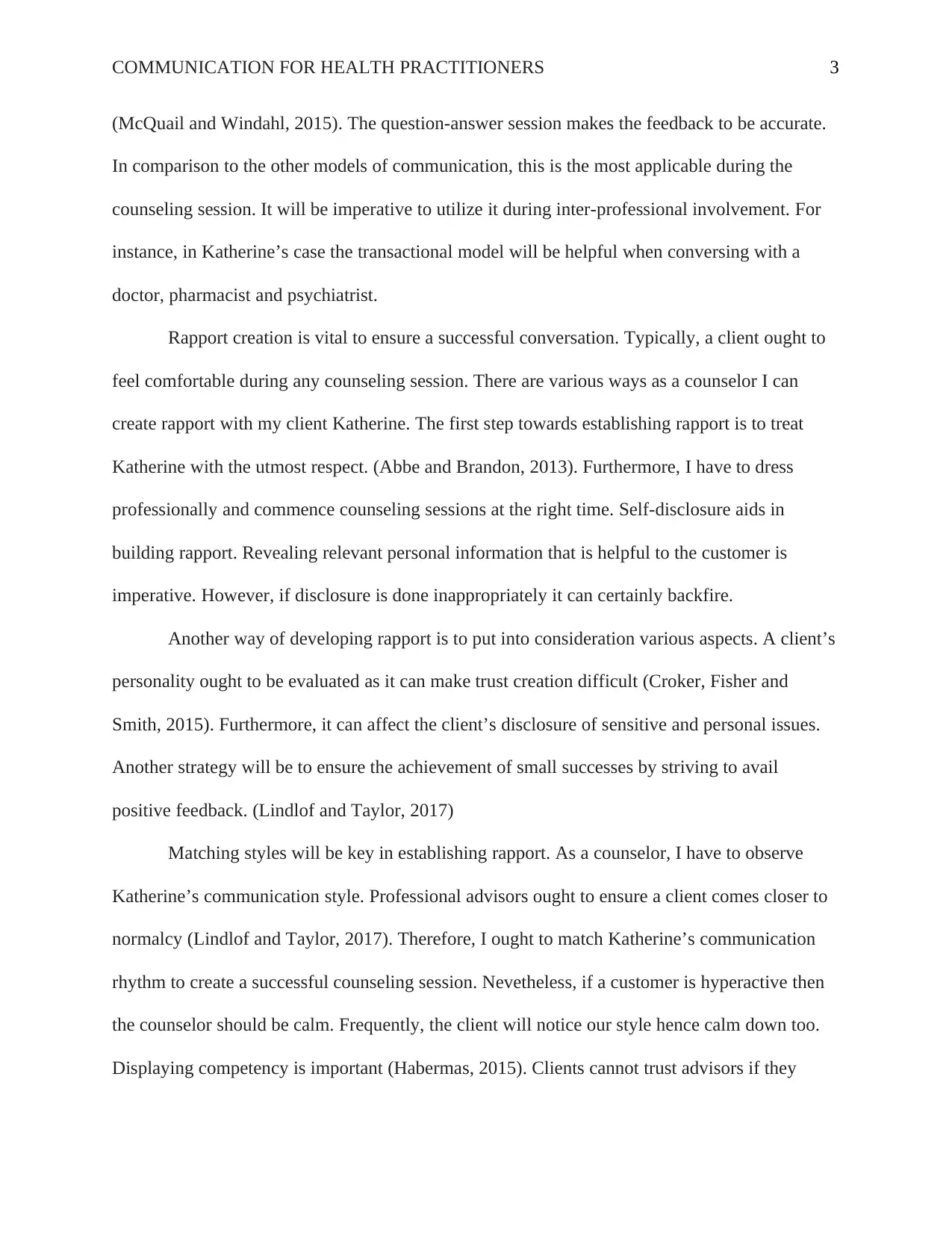
COMMUNICATION FOR HEALTH PRACTITIONERS 3
(McQuail and Windahl, 2015). The question-answer session makes the feedback to be accurate.
In comparison to the other models of communication, this is the most applicable during the
counseling session. It will be imperative to utilize it during inter-professional involvement. For
instance, in Katherine’s case the transactional model will be helpful when conversing with a
doctor, pharmacist and psychiatrist.
Rapport creation is vital to ensure a successful conversation. Typically, a client ought to
feel comfortable during any counseling session. There are various ways as a counselor I can
create rapport with my client Katherine. The first step towards establishing rapport is to treat
Katherine with the utmost respect. (Abbe and Brandon, 2013). Furthermore, I have to dress
professionally and commence counseling sessions at the right time. Self-disclosure aids in
building rapport. Revealing relevant personal information that is helpful to the customer is
imperative. However, if disclosure is done inappropriately it can certainly backfire.
Another way of developing rapport is to put into consideration various aspects. A client’s
personality ought to be evaluated as it can make trust creation difficult (Croker, Fisher and
Smith, 2015). Furthermore, it can affect the client’s disclosure of sensitive and personal issues.
Another strategy will be to ensure the achievement of small successes by striving to avail
positive feedback. (Lindlof and Taylor, 2017)
Matching styles will be key in establishing rapport. As a counselor, I have to observe
Katherine’s communication style. Professional advisors ought to ensure a client comes closer to
normalcy (Lindlof and Taylor, 2017). Therefore, I ought to match Katherine’s communication
rhythm to create a successful counseling session. Nevetheless, if a customer is hyperactive then
the counselor should be calm. Frequently, the client will notice our style hence calm down too.
Displaying competency is important (Habermas, 2015). Clients cannot trust advisors if they
(McQuail and Windahl, 2015). The question-answer session makes the feedback to be accurate.
In comparison to the other models of communication, this is the most applicable during the
counseling session. It will be imperative to utilize it during inter-professional involvement. For
instance, in Katherine’s case the transactional model will be helpful when conversing with a
doctor, pharmacist and psychiatrist.
Rapport creation is vital to ensure a successful conversation. Typically, a client ought to
feel comfortable during any counseling session. There are various ways as a counselor I can
create rapport with my client Katherine. The first step towards establishing rapport is to treat
Katherine with the utmost respect. (Abbe and Brandon, 2013). Furthermore, I have to dress
professionally and commence counseling sessions at the right time. Self-disclosure aids in
building rapport. Revealing relevant personal information that is helpful to the customer is
imperative. However, if disclosure is done inappropriately it can certainly backfire.
Another way of developing rapport is to put into consideration various aspects. A client’s
personality ought to be evaluated as it can make trust creation difficult (Croker, Fisher and
Smith, 2015). Furthermore, it can affect the client’s disclosure of sensitive and personal issues.
Another strategy will be to ensure the achievement of small successes by striving to avail
positive feedback. (Lindlof and Taylor, 2017)
Matching styles will be key in establishing rapport. As a counselor, I have to observe
Katherine’s communication style. Professional advisors ought to ensure a client comes closer to
normalcy (Lindlof and Taylor, 2017). Therefore, I ought to match Katherine’s communication
rhythm to create a successful counseling session. Nevetheless, if a customer is hyperactive then
the counselor should be calm. Frequently, the client will notice our style hence calm down too.
Displaying competency is important (Habermas, 2015). Clients cannot trust advisors if they
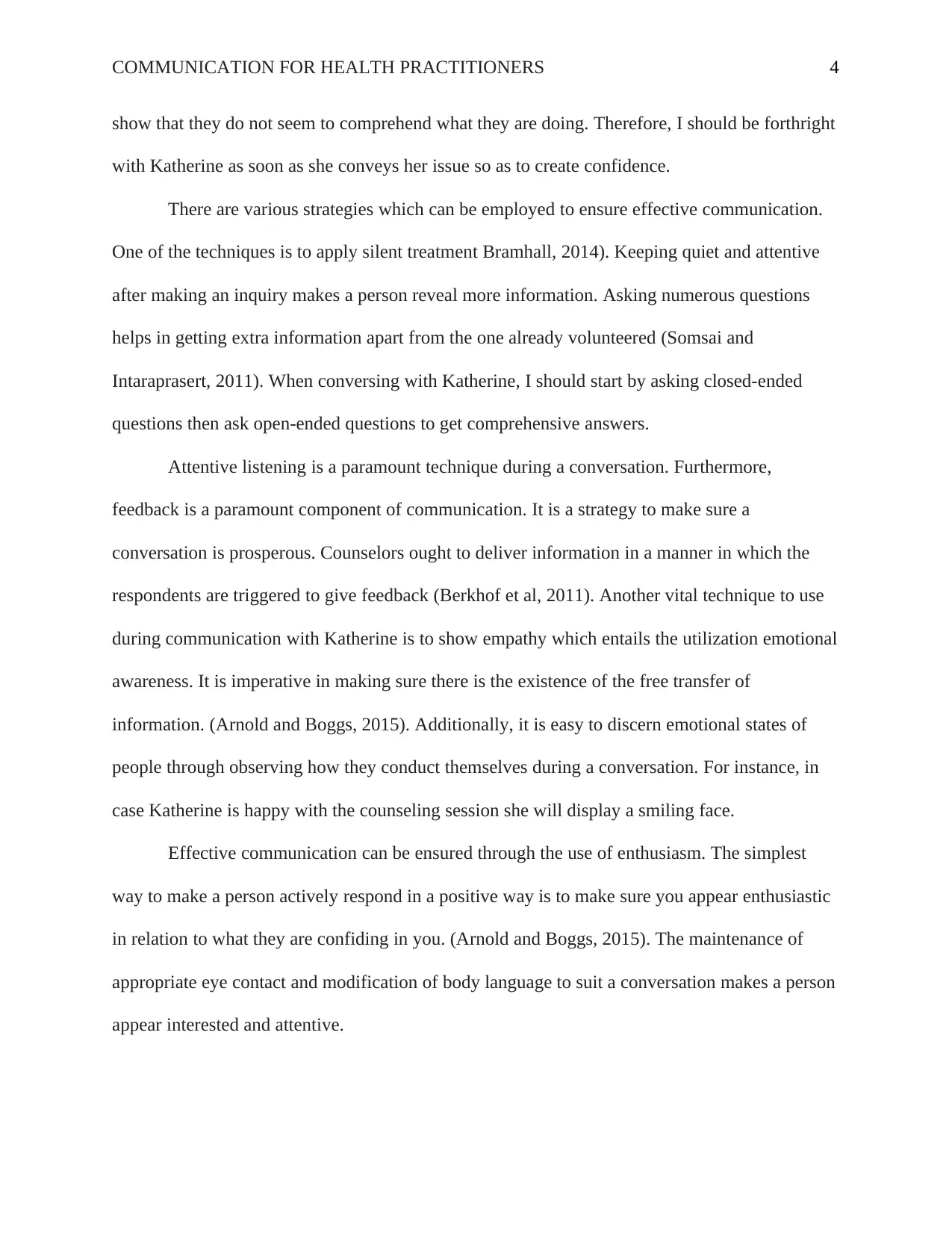
COMMUNICATION FOR HEALTH PRACTITIONERS 4
show that they do not seem to comprehend what they are doing. Therefore, I should be forthright
with Katherine as soon as she conveys her issue so as to create confidence.
There are various strategies which can be employed to ensure effective communication.
One of the techniques is to apply silent treatment Bramhall, 2014). Keeping quiet and attentive
after making an inquiry makes a person reveal more information. Asking numerous questions
helps in getting extra information apart from the one already volunteered (Somsai and
Intaraprasert, 2011). When conversing with Katherine, I should start by asking closed-ended
questions then ask open-ended questions to get comprehensive answers.
Attentive listening is a paramount technique during a conversation. Furthermore,
feedback is a paramount component of communication. It is a strategy to make sure a
conversation is prosperous. Counselors ought to deliver information in a manner in which the
respondents are triggered to give feedback (Berkhof et al, 2011). Another vital technique to use
during communication with Katherine is to show empathy which entails the utilization emotional
awareness. It is imperative in making sure there is the existence of the free transfer of
information. (Arnold and Boggs, 2015). Additionally, it is easy to discern emotional states of
people through observing how they conduct themselves during a conversation. For instance, in
case Katherine is happy with the counseling session she will display a smiling face.
Effective communication can be ensured through the use of enthusiasm. The simplest
way to make a person actively respond in a positive way is to make sure you appear enthusiastic
in relation to what they are confiding in you. (Arnold and Boggs, 2015). The maintenance of
appropriate eye contact and modification of body language to suit a conversation makes a person
appear interested and attentive.
show that they do not seem to comprehend what they are doing. Therefore, I should be forthright
with Katherine as soon as she conveys her issue so as to create confidence.
There are various strategies which can be employed to ensure effective communication.
One of the techniques is to apply silent treatment Bramhall, 2014). Keeping quiet and attentive
after making an inquiry makes a person reveal more information. Asking numerous questions
helps in getting extra information apart from the one already volunteered (Somsai and
Intaraprasert, 2011). When conversing with Katherine, I should start by asking closed-ended
questions then ask open-ended questions to get comprehensive answers.
Attentive listening is a paramount technique during a conversation. Furthermore,
feedback is a paramount component of communication. It is a strategy to make sure a
conversation is prosperous. Counselors ought to deliver information in a manner in which the
respondents are triggered to give feedback (Berkhof et al, 2011). Another vital technique to use
during communication with Katherine is to show empathy which entails the utilization emotional
awareness. It is imperative in making sure there is the existence of the free transfer of
information. (Arnold and Boggs, 2015). Additionally, it is easy to discern emotional states of
people through observing how they conduct themselves during a conversation. For instance, in
case Katherine is happy with the counseling session she will display a smiling face.
Effective communication can be ensured through the use of enthusiasm. The simplest
way to make a person actively respond in a positive way is to make sure you appear enthusiastic
in relation to what they are confiding in you. (Arnold and Boggs, 2015). The maintenance of
appropriate eye contact and modification of body language to suit a conversation makes a person
appear interested and attentive.
Secure Best Marks with AI Grader
Need help grading? Try our AI Grader for instant feedback on your assignments.
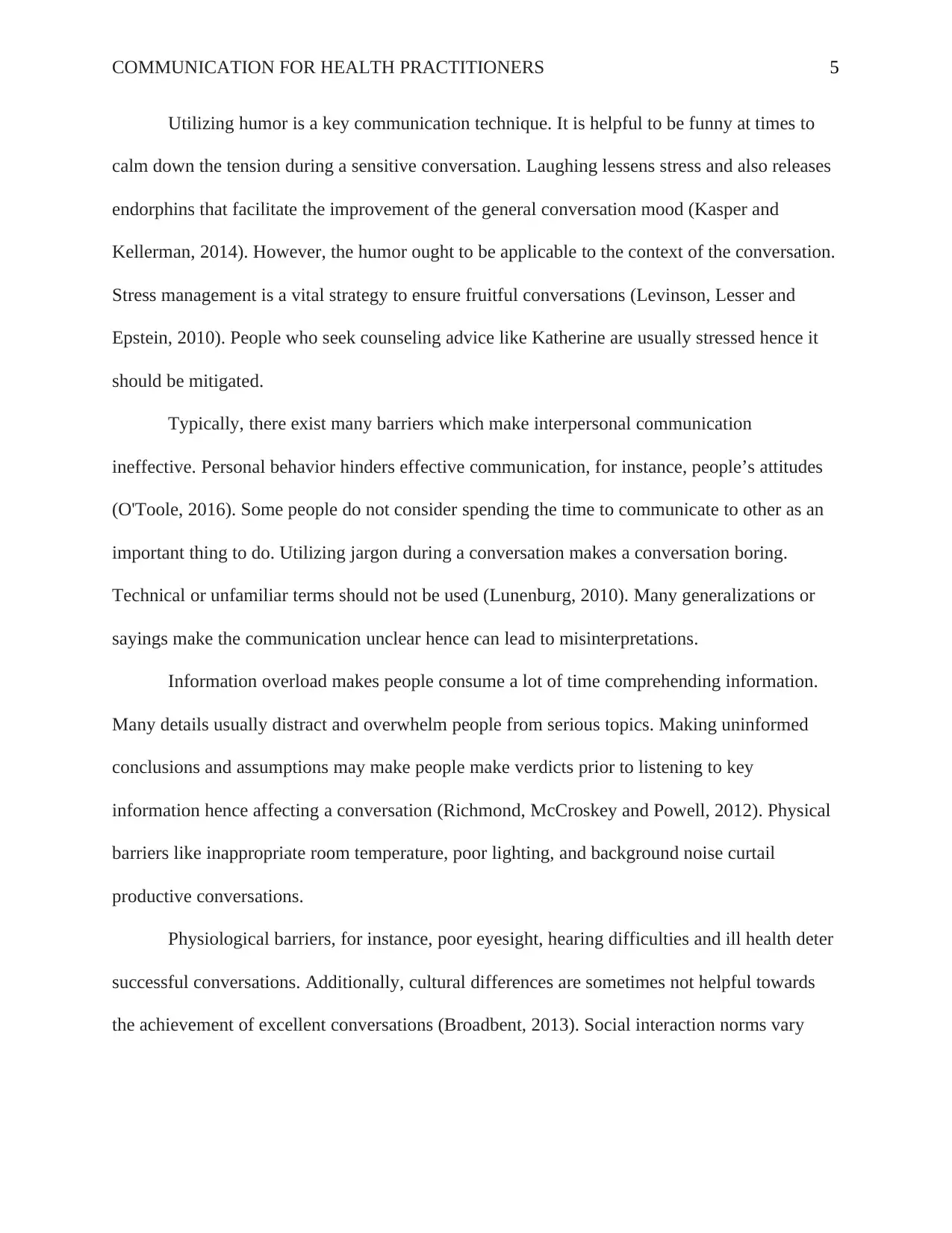
COMMUNICATION FOR HEALTH PRACTITIONERS 5
Utilizing humor is a key communication technique. It is helpful to be funny at times to
calm down the tension during a sensitive conversation. Laughing lessens stress and also releases
endorphins that facilitate the improvement of the general conversation mood (Kasper and
Kellerman, 2014). However, the humor ought to be applicable to the context of the conversation.
Stress management is a vital strategy to ensure fruitful conversations (Levinson, Lesser and
Epstein, 2010). People who seek counseling advice like Katherine are usually stressed hence it
should be mitigated.
Typically, there exist many barriers which make interpersonal communication
ineffective. Personal behavior hinders effective communication, for instance, people’s attitudes
(O'Toole, 2016). Some people do not consider spending the time to communicate to other as an
important thing to do. Utilizing jargon during a conversation makes a conversation boring.
Technical or unfamiliar terms should not be used (Lunenburg, 2010). Many generalizations or
sayings make the communication unclear hence can lead to misinterpretations.
Information overload makes people consume a lot of time comprehending information.
Many details usually distract and overwhelm people from serious topics. Making uninformed
conclusions and assumptions may make people make verdicts prior to listening to key
information hence affecting a conversation (Richmond, McCroskey and Powell, 2012). Physical
barriers like inappropriate room temperature, poor lighting, and background noise curtail
productive conversations.
Physiological barriers, for instance, poor eyesight, hearing difficulties and ill health deter
successful conversations. Additionally, cultural differences are sometimes not helpful towards
the achievement of excellent conversations (Broadbent, 2013). Social interaction norms vary
Utilizing humor is a key communication technique. It is helpful to be funny at times to
calm down the tension during a sensitive conversation. Laughing lessens stress and also releases
endorphins that facilitate the improvement of the general conversation mood (Kasper and
Kellerman, 2014). However, the humor ought to be applicable to the context of the conversation.
Stress management is a vital strategy to ensure fruitful conversations (Levinson, Lesser and
Epstein, 2010). People who seek counseling advice like Katherine are usually stressed hence it
should be mitigated.
Typically, there exist many barriers which make interpersonal communication
ineffective. Personal behavior hinders effective communication, for instance, people’s attitudes
(O'Toole, 2016). Some people do not consider spending the time to communicate to other as an
important thing to do. Utilizing jargon during a conversation makes a conversation boring.
Technical or unfamiliar terms should not be used (Lunenburg, 2010). Many generalizations or
sayings make the communication unclear hence can lead to misinterpretations.
Information overload makes people consume a lot of time comprehending information.
Many details usually distract and overwhelm people from serious topics. Making uninformed
conclusions and assumptions may make people make verdicts prior to listening to key
information hence affecting a conversation (Richmond, McCroskey and Powell, 2012). Physical
barriers like inappropriate room temperature, poor lighting, and background noise curtail
productive conversations.
Physiological barriers, for instance, poor eyesight, hearing difficulties and ill health deter
successful conversations. Additionally, cultural differences are sometimes not helpful towards
the achievement of excellent conversations (Broadbent, 2013). Social interaction norms vary
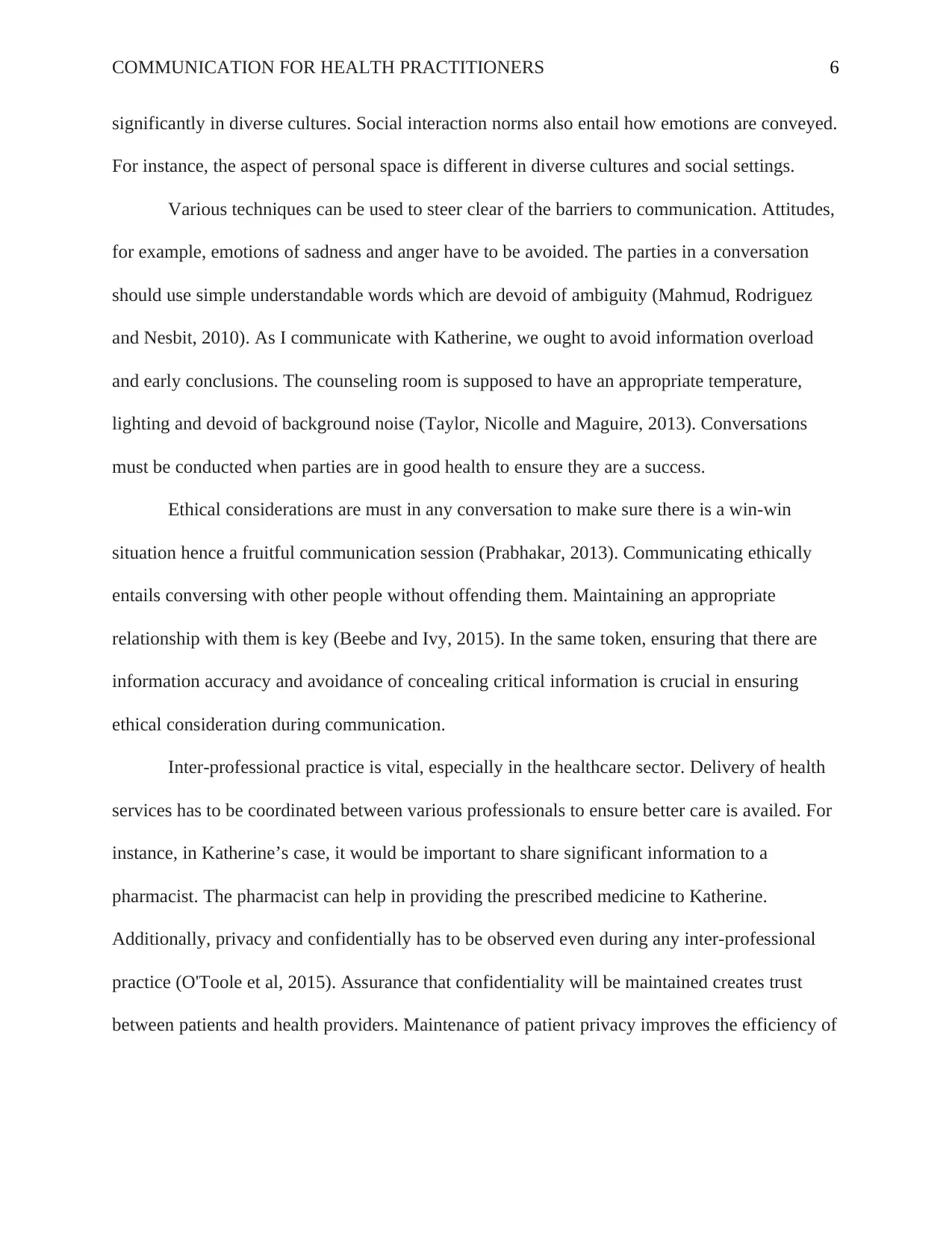
COMMUNICATION FOR HEALTH PRACTITIONERS 6
significantly in diverse cultures. Social interaction norms also entail how emotions are conveyed.
For instance, the aspect of personal space is different in diverse cultures and social settings.
Various techniques can be used to steer clear of the barriers to communication. Attitudes,
for example, emotions of sadness and anger have to be avoided. The parties in a conversation
should use simple understandable words which are devoid of ambiguity (Mahmud, Rodriguez
and Nesbit, 2010). As I communicate with Katherine, we ought to avoid information overload
and early conclusions. The counseling room is supposed to have an appropriate temperature,
lighting and devoid of background noise (Taylor, Nicolle and Maguire, 2013). Conversations
must be conducted when parties are in good health to ensure they are a success.
Ethical considerations are must in any conversation to make sure there is a win-win
situation hence a fruitful communication session (Prabhakar, 2013). Communicating ethically
entails conversing with other people without offending them. Maintaining an appropriate
relationship with them is key (Beebe and Ivy, 2015). In the same token, ensuring that there are
information accuracy and avoidance of concealing critical information is crucial in ensuring
ethical consideration during communication.
Inter-professional practice is vital, especially in the healthcare sector. Delivery of health
services has to be coordinated between various professionals to ensure better care is availed. For
instance, in Katherine’s case, it would be important to share significant information to a
pharmacist. The pharmacist can help in providing the prescribed medicine to Katherine.
Additionally, privacy and confidentially has to be observed even during any inter-professional
practice (O'Toole et al, 2015). Assurance that confidentiality will be maintained creates trust
between patients and health providers. Maintenance of patient privacy improves the efficiency of
significantly in diverse cultures. Social interaction norms also entail how emotions are conveyed.
For instance, the aspect of personal space is different in diverse cultures and social settings.
Various techniques can be used to steer clear of the barriers to communication. Attitudes,
for example, emotions of sadness and anger have to be avoided. The parties in a conversation
should use simple understandable words which are devoid of ambiguity (Mahmud, Rodriguez
and Nesbit, 2010). As I communicate with Katherine, we ought to avoid information overload
and early conclusions. The counseling room is supposed to have an appropriate temperature,
lighting and devoid of background noise (Taylor, Nicolle and Maguire, 2013). Conversations
must be conducted when parties are in good health to ensure they are a success.
Ethical considerations are must in any conversation to make sure there is a win-win
situation hence a fruitful communication session (Prabhakar, 2013). Communicating ethically
entails conversing with other people without offending them. Maintaining an appropriate
relationship with them is key (Beebe and Ivy, 2015). In the same token, ensuring that there are
information accuracy and avoidance of concealing critical information is crucial in ensuring
ethical consideration during communication.
Inter-professional practice is vital, especially in the healthcare sector. Delivery of health
services has to be coordinated between various professionals to ensure better care is availed. For
instance, in Katherine’s case, it would be important to share significant information to a
pharmacist. The pharmacist can help in providing the prescribed medicine to Katherine.
Additionally, privacy and confidentially has to be observed even during any inter-professional
practice (O'Toole et al, 2015). Assurance that confidentiality will be maintained creates trust
between patients and health providers. Maintenance of patient privacy improves the efficiency of
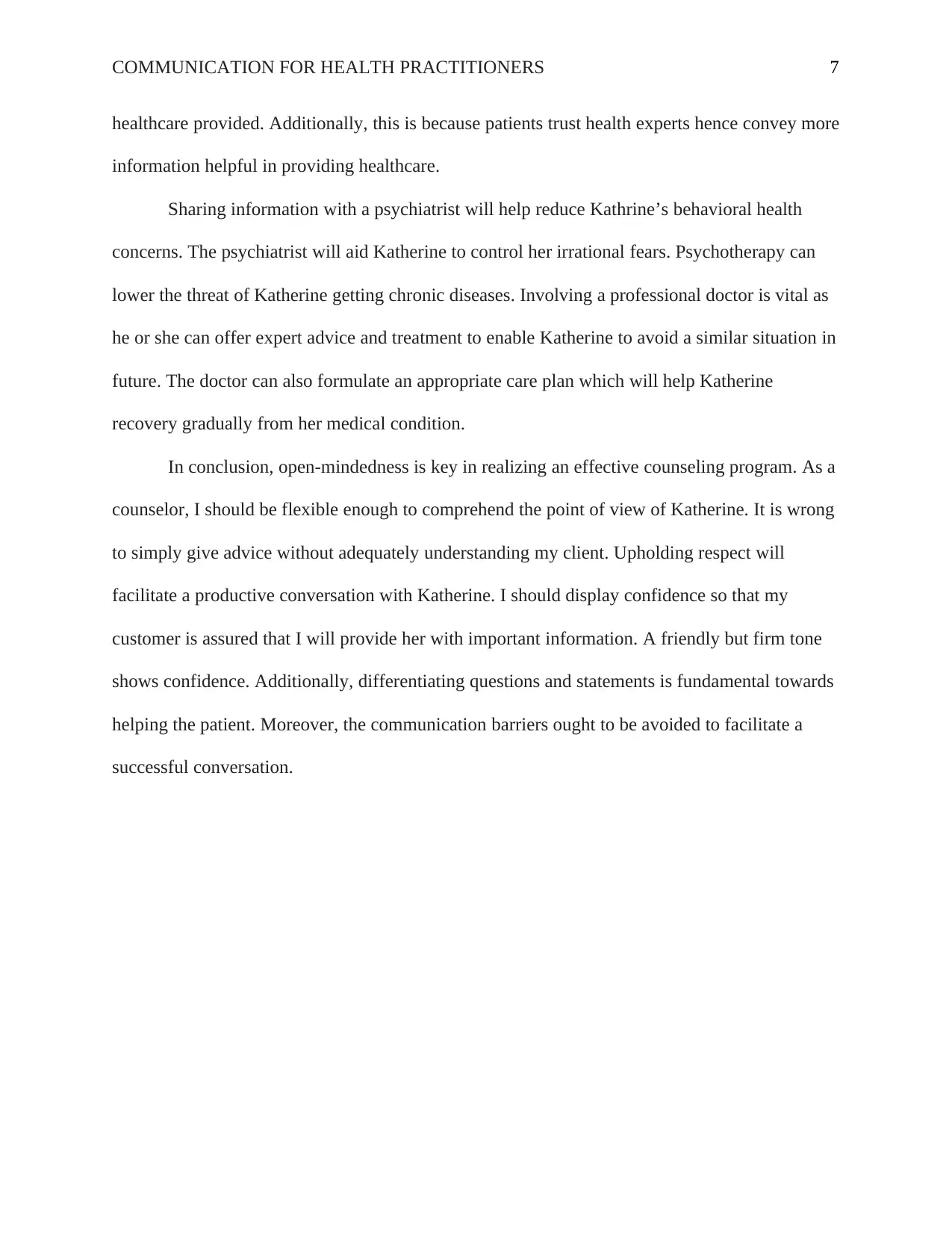
COMMUNICATION FOR HEALTH PRACTITIONERS 7
healthcare provided. Additionally, this is because patients trust health experts hence convey more
information helpful in providing healthcare.
Sharing information with a psychiatrist will help reduce Kathrine’s behavioral health
concerns. The psychiatrist will aid Katherine to control her irrational fears. Psychotherapy can
lower the threat of Katherine getting chronic diseases. Involving a professional doctor is vital as
he or she can offer expert advice and treatment to enable Katherine to avoid a similar situation in
future. The doctor can also formulate an appropriate care plan which will help Katherine
recovery gradually from her medical condition.
In conclusion, open-mindedness is key in realizing an effective counseling program. As a
counselor, I should be flexible enough to comprehend the point of view of Katherine. It is wrong
to simply give advice without adequately understanding my client. Upholding respect will
facilitate a productive conversation with Katherine. I should display confidence so that my
customer is assured that I will provide her with important information. A friendly but firm tone
shows confidence. Additionally, differentiating questions and statements is fundamental towards
helping the patient. Moreover, the communication barriers ought to be avoided to facilitate a
successful conversation.
healthcare provided. Additionally, this is because patients trust health experts hence convey more
information helpful in providing healthcare.
Sharing information with a psychiatrist will help reduce Kathrine’s behavioral health
concerns. The psychiatrist will aid Katherine to control her irrational fears. Psychotherapy can
lower the threat of Katherine getting chronic diseases. Involving a professional doctor is vital as
he or she can offer expert advice and treatment to enable Katherine to avoid a similar situation in
future. The doctor can also formulate an appropriate care plan which will help Katherine
recovery gradually from her medical condition.
In conclusion, open-mindedness is key in realizing an effective counseling program. As a
counselor, I should be flexible enough to comprehend the point of view of Katherine. It is wrong
to simply give advice without adequately understanding my client. Upholding respect will
facilitate a productive conversation with Katherine. I should display confidence so that my
customer is assured that I will provide her with important information. A friendly but firm tone
shows confidence. Additionally, differentiating questions and statements is fundamental towards
helping the patient. Moreover, the communication barriers ought to be avoided to facilitate a
successful conversation.
Paraphrase This Document
Need a fresh take? Get an instant paraphrase of this document with our AI Paraphraser
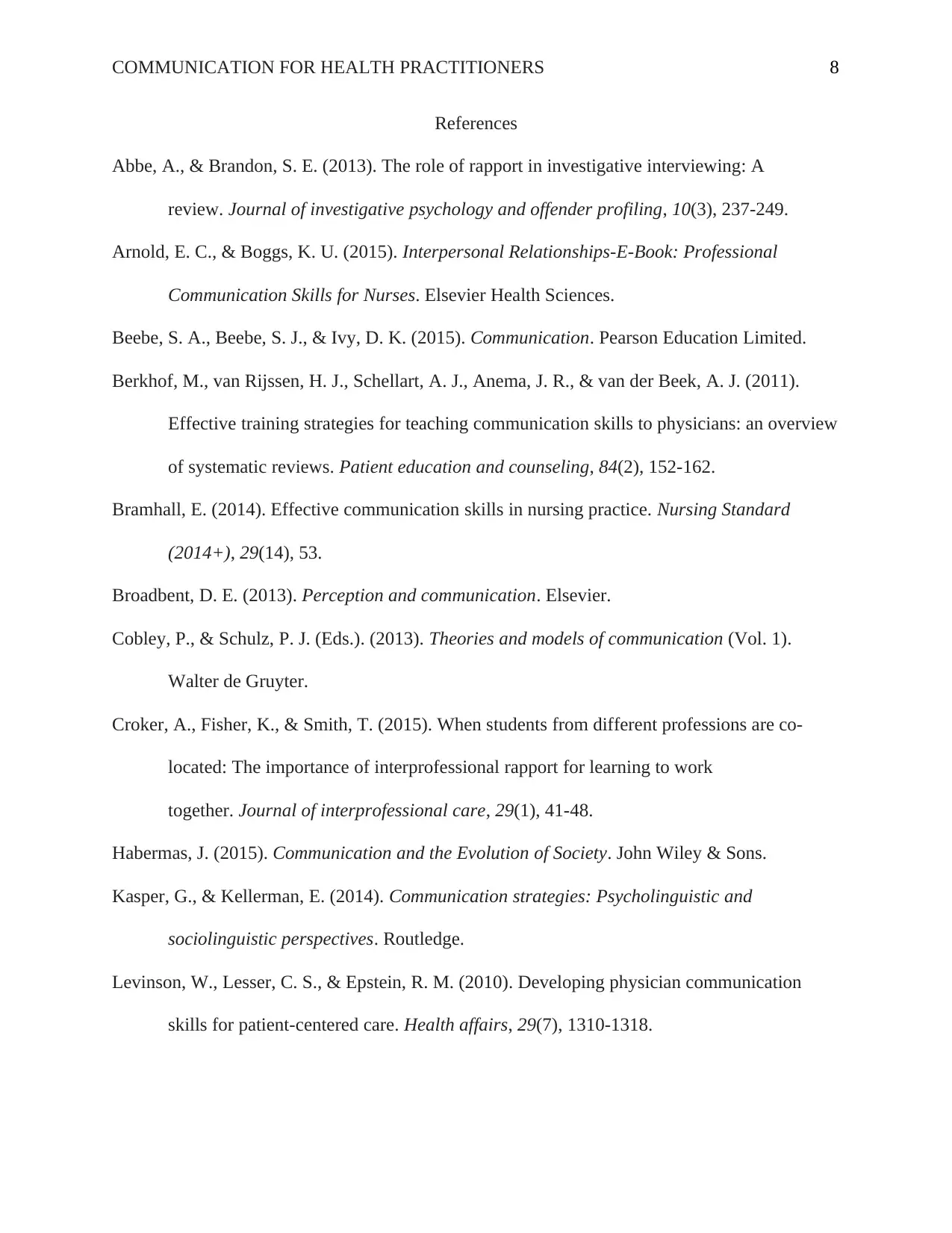
COMMUNICATION FOR HEALTH PRACTITIONERS 8
References
Abbe, A., & Brandon, S. E. (2013). The role of rapport in investigative interviewing: A
review. Journal of investigative psychology and offender profiling, 10(3), 237-249.
Arnold, E. C., & Boggs, K. U. (2015). Interpersonal Relationships-E-Book: Professional
Communication Skills for Nurses. Elsevier Health Sciences.
Beebe, S. A., Beebe, S. J., & Ivy, D. K. (2015). Communication. Pearson Education Limited.
Berkhof, M., van Rijssen, H. J., Schellart, A. J., Anema, J. R., & van der Beek, A. J. (2011).
Effective training strategies for teaching communication skills to physicians: an overview
of systematic reviews. Patient education and counseling, 84(2), 152-162.
Bramhall, E. (2014). Effective communication skills in nursing practice. Nursing Standard
(2014+), 29(14), 53.
Broadbent, D. E. (2013). Perception and communication. Elsevier.
Cobley, P., & Schulz, P. J. (Eds.). (2013). Theories and models of communication (Vol. 1).
Walter de Gruyter.
Croker, A., Fisher, K., & Smith, T. (2015). When students from different professions are co-
located: The importance of interprofessional rapport for learning to work
together. Journal of interprofessional care, 29(1), 41-48.
Habermas, J. (2015). Communication and the Evolution of Society. John Wiley & Sons.
Kasper, G., & Kellerman, E. (2014). Communication strategies: Psycholinguistic and
sociolinguistic perspectives. Routledge.
Levinson, W., Lesser, C. S., & Epstein, R. M. (2010). Developing physician communication
skills for patient-centered care. Health affairs, 29(7), 1310-1318.
References
Abbe, A., & Brandon, S. E. (2013). The role of rapport in investigative interviewing: A
review. Journal of investigative psychology and offender profiling, 10(3), 237-249.
Arnold, E. C., & Boggs, K. U. (2015). Interpersonal Relationships-E-Book: Professional
Communication Skills for Nurses. Elsevier Health Sciences.
Beebe, S. A., Beebe, S. J., & Ivy, D. K. (2015). Communication. Pearson Education Limited.
Berkhof, M., van Rijssen, H. J., Schellart, A. J., Anema, J. R., & van der Beek, A. J. (2011).
Effective training strategies for teaching communication skills to physicians: an overview
of systematic reviews. Patient education and counseling, 84(2), 152-162.
Bramhall, E. (2014). Effective communication skills in nursing practice. Nursing Standard
(2014+), 29(14), 53.
Broadbent, D. E. (2013). Perception and communication. Elsevier.
Cobley, P., & Schulz, P. J. (Eds.). (2013). Theories and models of communication (Vol. 1).
Walter de Gruyter.
Croker, A., Fisher, K., & Smith, T. (2015). When students from different professions are co-
located: The importance of interprofessional rapport for learning to work
together. Journal of interprofessional care, 29(1), 41-48.
Habermas, J. (2015). Communication and the Evolution of Society. John Wiley & Sons.
Kasper, G., & Kellerman, E. (2014). Communication strategies: Psycholinguistic and
sociolinguistic perspectives. Routledge.
Levinson, W., Lesser, C. S., & Epstein, R. M. (2010). Developing physician communication
skills for patient-centered care. Health affairs, 29(7), 1310-1318.
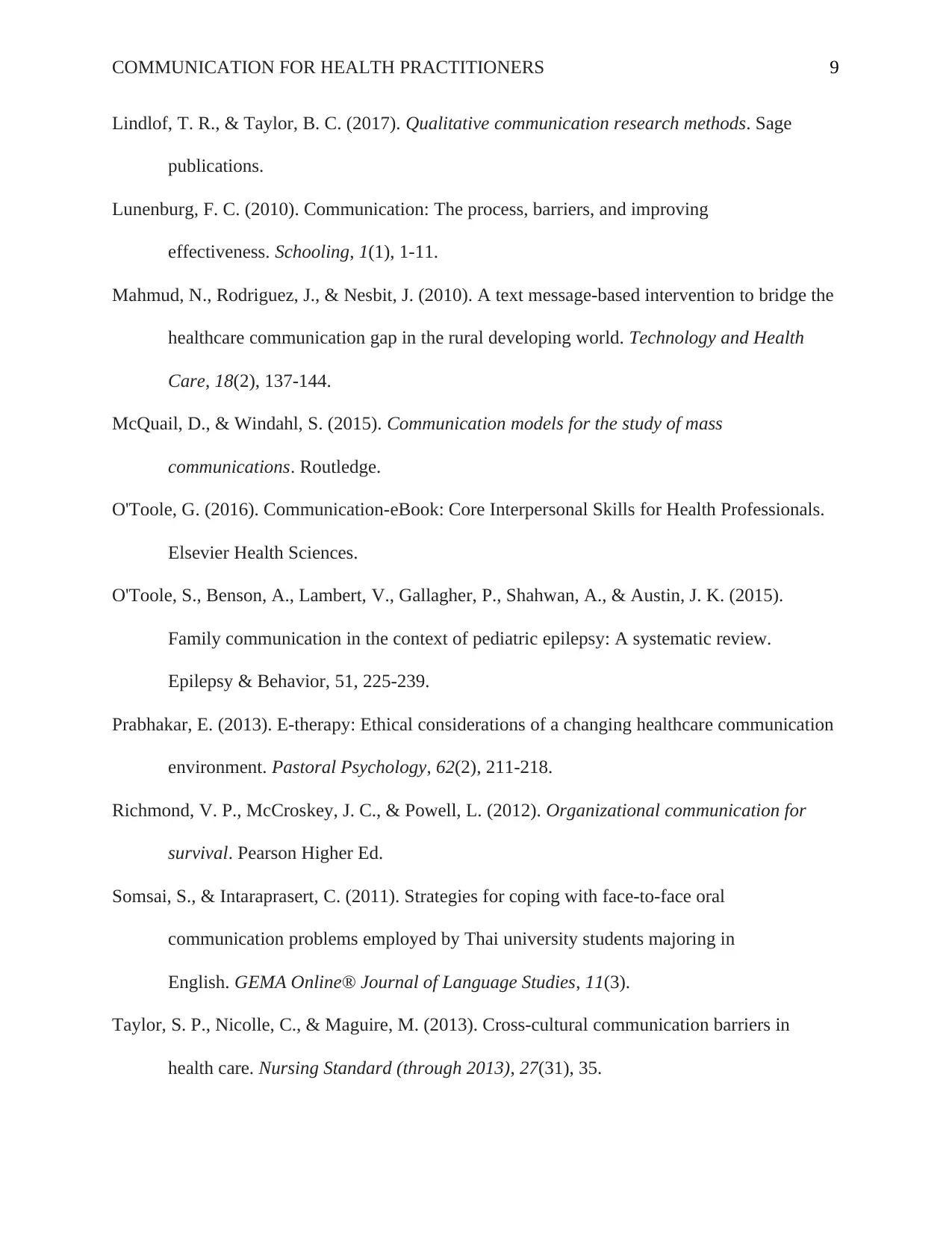
COMMUNICATION FOR HEALTH PRACTITIONERS 9
Lindlof, T. R., & Taylor, B. C. (2017). Qualitative communication research methods. Sage
publications.
Lunenburg, F. C. (2010). Communication: The process, barriers, and improving
effectiveness. Schooling, 1(1), 1-11.
Mahmud, N., Rodriguez, J., & Nesbit, J. (2010). A text message-based intervention to bridge the
healthcare communication gap in the rural developing world. Technology and Health
Care, 18(2), 137-144.
McQuail, D., & Windahl, S. (2015). Communication models for the study of mass
communications. Routledge.
O'Toole, G. (2016). Communication-eBook: Core Interpersonal Skills for Health Professionals.
Elsevier Health Sciences.
O'Toole, S., Benson, A., Lambert, V., Gallagher, P., Shahwan, A., & Austin, J. K. (2015).
Family communication in the context of pediatric epilepsy: A systematic review.
Epilepsy & Behavior, 51, 225-239.
Prabhakar, E. (2013). E-therapy: Ethical considerations of a changing healthcare communication
environment. Pastoral Psychology, 62(2), 211-218.
Richmond, V. P., McCroskey, J. C., & Powell, L. (2012). Organizational communication for
survival. Pearson Higher Ed.
Somsai, S., & Intaraprasert, C. (2011). Strategies for coping with face-to-face oral
communication problems employed by Thai university students majoring in
English. GEMA Online® Journal of Language Studies, 11(3).
Taylor, S. P., Nicolle, C., & Maguire, M. (2013). Cross-cultural communication barriers in
health care. Nursing Standard (through 2013), 27(31), 35.
Lindlof, T. R., & Taylor, B. C. (2017). Qualitative communication research methods. Sage
publications.
Lunenburg, F. C. (2010). Communication: The process, barriers, and improving
effectiveness. Schooling, 1(1), 1-11.
Mahmud, N., Rodriguez, J., & Nesbit, J. (2010). A text message-based intervention to bridge the
healthcare communication gap in the rural developing world. Technology and Health
Care, 18(2), 137-144.
McQuail, D., & Windahl, S. (2015). Communication models for the study of mass
communications. Routledge.
O'Toole, G. (2016). Communication-eBook: Core Interpersonal Skills for Health Professionals.
Elsevier Health Sciences.
O'Toole, S., Benson, A., Lambert, V., Gallagher, P., Shahwan, A., & Austin, J. K. (2015).
Family communication in the context of pediatric epilepsy: A systematic review.
Epilepsy & Behavior, 51, 225-239.
Prabhakar, E. (2013). E-therapy: Ethical considerations of a changing healthcare communication
environment. Pastoral Psychology, 62(2), 211-218.
Richmond, V. P., McCroskey, J. C., & Powell, L. (2012). Organizational communication for
survival. Pearson Higher Ed.
Somsai, S., & Intaraprasert, C. (2011). Strategies for coping with face-to-face oral
communication problems employed by Thai university students majoring in
English. GEMA Online® Journal of Language Studies, 11(3).
Taylor, S. P., Nicolle, C., & Maguire, M. (2013). Cross-cultural communication barriers in
health care. Nursing Standard (through 2013), 27(31), 35.
1 out of 9
Your All-in-One AI-Powered Toolkit for Academic Success.
+13062052269
info@desklib.com
Available 24*7 on WhatsApp / Email
![[object Object]](/_next/static/media/star-bottom.7253800d.svg)
Unlock your academic potential
© 2024 | Zucol Services PVT LTD | All rights reserved.
